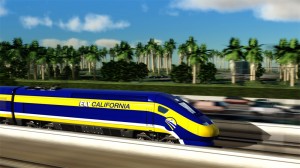 The California High Speed Rail Authority released its 2018 draft business plan on Friday, and the news is not good. Not only have costs gone up with no new revenue in site, the authority now admits it’s unlikely to build any actual high speed rail service for at least a decade.
The California High Speed Rail Authority released its 2018 draft business plan on Friday, and the news is not good. Not only have costs gone up with no new revenue in site, the authority now admits it’s unlikely to build any actual high speed rail service for at least a decade.
How did we get to this unfortunate place? Since voters originally approved a $10 billion bond issue to launch the system in 2008, two important events happened:
1) Central Valley representatives insisted the system start in the Valley, with no benefit to the coastal cities. While the system was originally billed as a quick way to serve Los Angeles and San Francisco, San Joaquin Valley representatives saw it as an opportunity to diversify and grow the Central Valley economies, by linking this largely impoverished part of the state to the thriving coastal cities. As a result, they insisted on starting the system in the Valley, where it would provide no benefit to the major population centers on the coasts. It’s the equivalent of starting LA Metro Rail in the suburban San Fernando Valley, or BART in the East Bay suburbs. Most train systems need to go back to voters for multiple rounds of funding. But in this case, voters in Los Angeles and San Francisco have no stake in the system. Had the system instead been started between San Francisco and San Jose and also between Los Angeles Union Station and Anaheim (and up to northern Los Angeles County), there would have been something to show for the initial investment and more political support to complete it (and less litigation and opposition from the Central Valley residents).
2) Republicans took over Congress in 2010 and have since refused to return Californians’ tax dollars to the project. With that Tea Party election that year, Republicans withdrew the federal purse strings for the project. While the federal government is happy to pay 90 to 100 percent of the costs of new highways, and 50 percent of the costs for new rail transit, so far California residents have been on the hook for $17 billion of the roughly $20 billion in costs to date.
Nothing can be done about the first event, which is a mistake that the authority has since tried to rectify by dedicating some funds to improve Caltrain and Metrolink in the coastal cities.
The second event could potentially be remedied this November, if a “blue wave” removes Republican control of Congress. While President Trump could veto any subsequent infrastructure plans that funds high speed rail, he will have lost leverage at that point. And revenue to fund non-automobile infrastructure like high speed rail could come from sources like a new carbon tax, passed via reconciliation in the Senate.
Still, hoping for a political shift is not exactly a great business plan. In the meantime, the authority appears set to finish the 119 mile first segment in the Valley. Then, absent new revenue, they’ll probably hand it over to Amtrak to run regular diesel trains on it, biding time until political and economic fortunes change in the state and the country at large.


